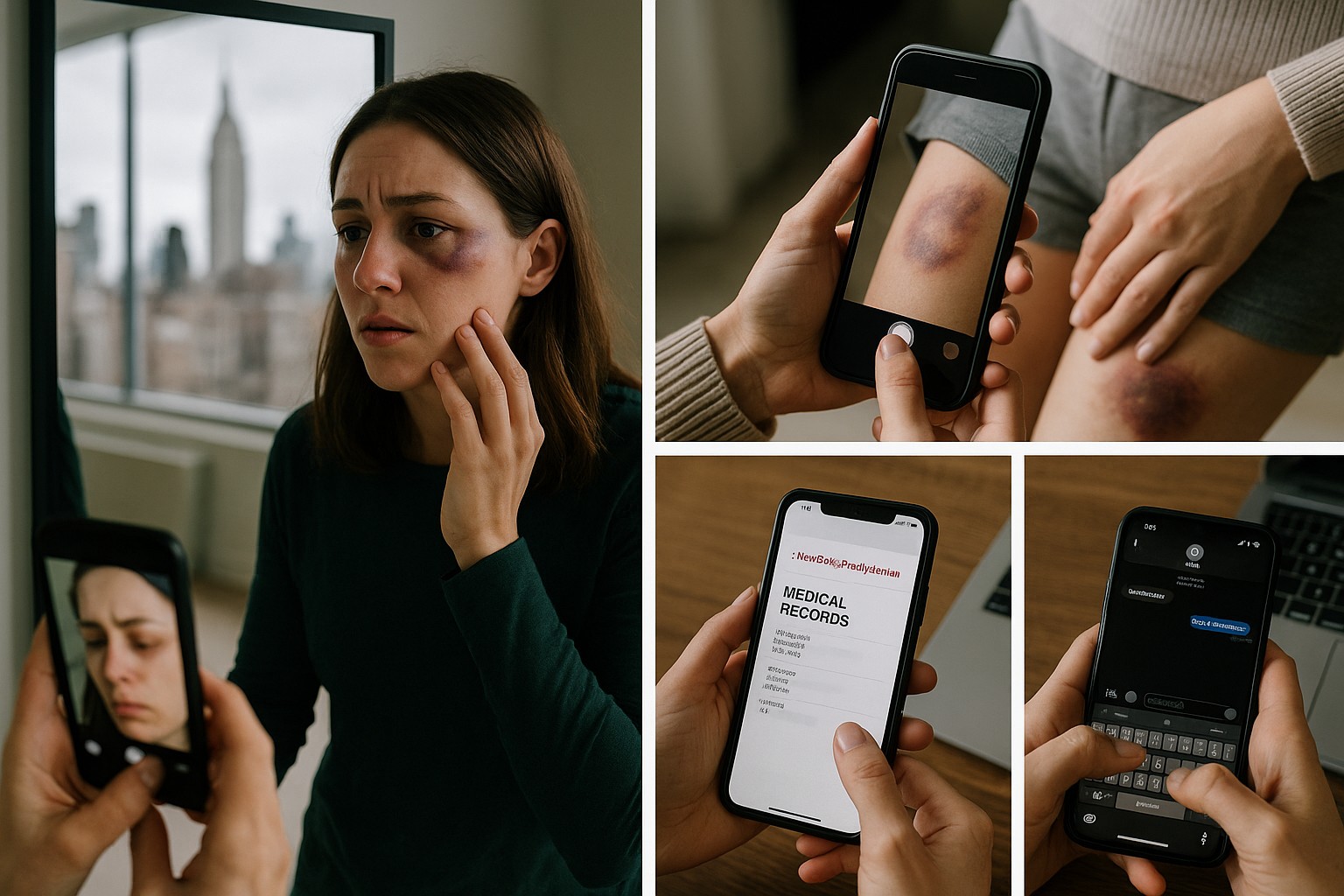Court-Ready Evidence in NYC: Photographing Injuries, Downloading NYP Medical Records & Preserving Texts
This guide provides NYC survivors with a masterclass on preparing a court-ready evidence package, including detailed instructions on documenting physical injuries, archiving digital messages, and leveraging medical records from institutions like NewYork-Presbyterian.

In the New York City legal system, a domestic violence case is built on a foundation of evidence. Whether you are seeking a Family Court Order of Protection or are involved in a criminal case, presenting a clear and compelling narrative is critical. This guide is a masterclass in preparing a "pro" evidence package, teaching you the best practices for documenting abuse in NYC—from photographing injuries to leveraging medical records from institutions like NewYork-Presbyterian (NYP).
The Foundation: Why Your Evidence Matters in NYC Courts ⚖️
Judges and prosecutors in NYC courts rely on evidence to make a decision. Your evidence package serves as a verifiable timeline, substantiating your claims and providing an objective record of the abuse. A well-documented case makes it easier for the court to see through any attempts by the abuser to discredit your account. It shows a pattern of abuse, which is crucial for proving your case.
Pro-Tips for Photographing Physical Evidence 📸
If you have physical injuries, documenting them correctly is paramount. Follow these tips to ensure your photos are "court-ready":
-
Act Quickly and Seek Medical Care: The first step is always to seek medical attention at an NYC hospital or clinic, such as one within the NewYork-Presbyterian network. A medical record is powerful, independent evidence.
-
Use Good Lighting and Context: Take photos in a well-lit area without a flash. For each injury, take a wide shot to show its location on your body, followed by a close-up.
-
Include Scale and Date: In at least one photo, place a ruler or a coin next to the injury for scale. Ensure the photo's metadata includes the date and time, or take a picture of a newspaper or digital clock with the injury.
-
Preserve the Original: Never delete any of the photos, even if they aren't perfect. They are part of a complete record.
Pro-Tips for Digital Evidence (Texts, Emails & Social Media) 📱
Digital communication is often a goldmine for evidence of threats, harassment, and coercive control.
-
Screenshot with a Purpose: Take screenshots of every relevant text message, email, or social media post.
-
Include the "Four C's": For a screenshot to be most effective, it must show the Content of the message, the Contact (the sender and recipient), the Date, and the Time.
-
Capture the Full Conversation: It is often more powerful to screenshot entire conversations, not just individual messages. This helps a judge see a pattern of behavior over time.
-
Secure Your Files: Print out all relevant screenshots and also save them to a secure, private cloud storage service that the abuser cannot access.
Leveraging Medical Evidence (NYP & Other NYC Records) 🏥
Medical records are an essential part of an evidence package. They serve as objective proof of your injuries and the date they occurred.
-
Request Your Records: In New York, you have the right to request your medical records. Contact the medical records department of any hospital you visited.
-
Use Patient Portals: Many healthcare providers in NYC, including NewYork-Presbyterian, use online patient portals. These portals allow you to easily download visit summaries, doctor's notes, and lab results, which can be invaluable evidence.
-
Look for Key Details: When reviewing your records, look for any notes from the doctor or nurse that describe the cause of your injuries, as this can be powerful evidence in court.
Putting It All Together: Creating a Court-Ready Package
Once you have gathered all your evidence, the final step is to organize it for the court. Organize your evidence in a binder or a folder in chronological order. Create a simple table of contents that lists the type of evidence (e.g., "Photos of Bruises," "Texts from Abuser") and the dates it covers. This organization makes it easy for the court to review your case and understand the full pattern of abuse.
Frequently Asked Questions (FAQs)
1. Do I need a lawyer to prepare this evidence package?
While you do not legally need a lawyer, it is highly recommended. A legal aid organization in NYC can help you prepare a professional and comprehensive package that meets all court requirements.
2. Is it okay if my photos aren't professional quality?
Yes. Your photos do not need to be professional. The most important things are that they are clear, in focus, and include the date and context to be easily understood by a judge.
3. How far back can I go to collect evidence?
You should collect evidence from as far back as you can to show a pattern of abuse. A domestic violence case is often about a history of abuse, not just a single, recent incident.
4. Can I use screenshots from my old phone?
Yes. As long as the screenshots clearly show the message content, sender, date, and time, they are valid evidence. If possible, save them to a secure location before you get rid of the old phone.
5. What if my abuser deleted the evidence from their phone?
While this can make it more difficult, the evidence you have saved from your own device is still valid. Your testimony, supported by your preserved evidence, is the most important part of your case.
6. Where can I get help in NYC to prepare my evidence package?
NYC has numerous legal aid organizations that specialize in domestic violence. These groups can provide free legal counsel, help you gather and organize your evidence, and assist with court proceedings.
